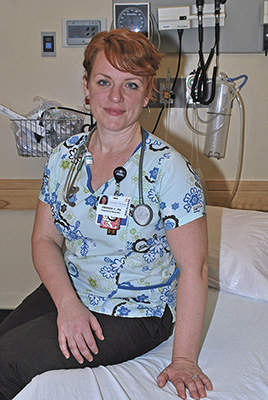| Thankfully, nursing has come a long way since then. But even in the days when lack of respect and recognition were the norm, nurses were making a huge difference in health-care delivery, policy, ethics, and more. As Betty Rambur, professor of nursing and health policy at the University of Vermont Medical Center points out, “Florence Nightingale redesigned health care during the Crimean War in such a way that mortality declined dramatically.”
Margaret Sanger, who worked with poor women on New York’s Lower East Side and watched them die from self-induced abortions, advocated for birth control and launched what is now Planned Parenthood. Mary Breckenridge started the Frontier Nursing Service in Kentucky in 1925 to serve women and children in rural areas.
More recently, Cicely Saunders founded the first modern hospice in London in 1967 where she fostered the culture of palliative care. And in our own time, Mary Naylor’s research helped lead to the design of a Transitional Care Model that addresses “the negative effects associated with common breakdowns in care when older adults with complex needs transition from acute care settings to other care settings or their homes.”
Dr. Linda Aiken’s work has addressed patient safety and its relation to nursing care. She and a colleague are credited with coining the term failure to rescue, defined in a 2003 American Journal of Nursing article as “a clinician’s inability to save a hospitalized patient’s life when he experiences a complication.” According to Emily McGee, a flight nurse blogging on Advanced Health Care Network for Nurses, “nursing basics remain a vital part of [nurses] role in patient care. The ability to deal with patients, who despite our best efforts still become critically ill, is one of the most important skills we possess.” |
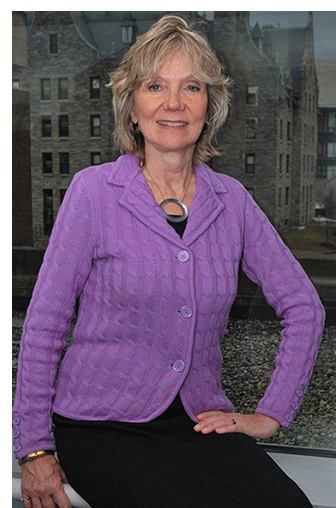
Betty Rambur photo: Jan Doerler
|

| Deb Clark, BSN
After working in neurosurgery, traveling to Europe, spending time as a rehabilitation nurse, and doing hospice work in Seattle, Deb Clark moved to Stowe, Vermont, where she joined the hospice team at Chittenden County’s Visiting Nurse Association. She then went on to work as a research nurse in hematology/oncology before providing direct care in the chemo infusion room at the University of Vermont Medical Center’s Hematology/Oncology Out-patient Clinic, where she works now.
“I’m so grateful for having chosen to be a nurse,” she says. “Nursing keeps me growing and learning. It helps knowing I have given patients and their families the utmost care I possibly can as I walk this time with them. I am honored to be with these people during a critical time, and to help them with their quality of life. We are present in the moment together, and I am grateful for that deep connection.” |
Never a Better Time to Be a Nurse
Today “there has never been a more exciting time to be a nurse,” says Pat Donehower, a home health nurse, administrator, consultant, and lecturer at UVM’s College of Nursing and Health Sciences. Winner of the 2014 Outstanding Nurse Leader in a Community Setting award from the Visiting Nurse Association of Chittenden and Grand Isle Counties, she adds, “There are fabulous job opportunities in administration, research, or practice settings.”
Mari Cordes agrees. “I’m so proud of my profession,” she says. Cordes, who specializes in vascular access nursing and is vice president for Health Care with the American Federation of Teachers/Vermont, has seen major changes in the practice of nursing over the 27 years she’s been a nurse.“
Why Did I Become an Oncology Nurse?
- I make a difference.
- I am continually strengthened by the courage of my patients and their families.
- The biology of the disease is fascinating.
- It is less about dying and more about living.
- It is an opportunity to accompany patients on their journey.
- Every aspect of my being is challenged.
- The patients give back to us, such as a grateful smile at the end of a long, hard day.
- It is an environment of lifelong learning.
- The challenges of patient care bring out the best in each and every team member.
- It is where the purpose of nursing is made real.
(Medland, 2004)
|
|
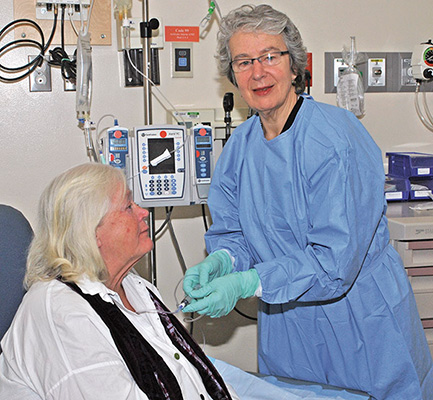
Deb Clark prepares to administer chemo to patient Barbara Bardin at the chemo infusion room at the University of Vermont Medical Center. photo: Jan Doerler |
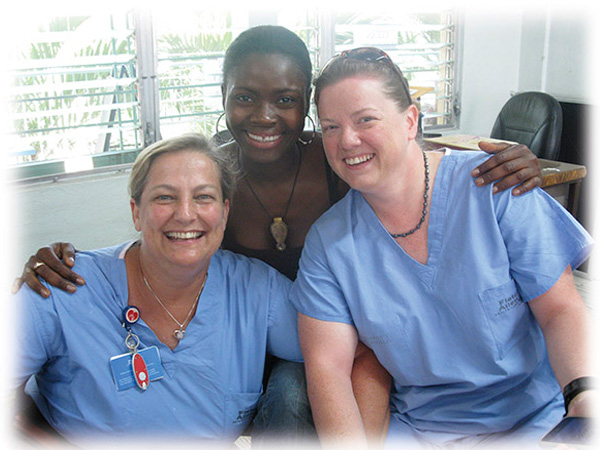
Mary Cordes (left), vascular access nurse, and Susan Wallace (right), pediatric nurse, both from UVM Medical Center, traveled to Port-au-Prince, Haiti, as part of medical disaster relief after the devastating 2010 earthquake. Shown here with Haitian Miquette Denie (center), coordinator of the triage center.
photo: courtesy Mary Cordes
Over time I witnessed many of us stepping forward to demand our rightful place in health care,” the labor activist says. “That was our responsibility. No one was going to hand it to us. And the more we demanded, the more respect we received from physicians. Now most physicians value nurses as professionals and want their distinct input.”
Some of the new respect for nurses may be in place because increasingly, nurses are getting advance degrees enabling them to take on leadership roles in research, on hospital boards, and in continuing dialogues around such issues as cost containment, ethics, and training. For example, Aiken’s 2003 research demonstrating that hospital nurses with a bachelor’s degree or higher gave patients a “substantial survival advantage” was applauded as groundbreaking.
Her research found, for example, that a 10 percent increase in the proportion of nurses with a BSN (bachelor of science in nursing) in hospitals decreased the risk of patient death and failure to rescue by five percent. And if the proportion of BSN nurses in all hospitals was 60 percent rather than 20 percent, 17.8 fewer deaths per 1,000 surgical patients would be expected.
This kind of finding is consistent with numerous subsequent studies that focus on the benefits of creating a more highly qualified nursing workforce and is supported by a landmark 2010 report, The Future of Nursing, issued by the Institute of Medicine (IOM). The report calls for increasing the number of baccalaureate-prepared nurses in the workforce to 80 percent and doubling the population of nurses with doctorates in order to respond “to the demands of an evolving health care system and meet the changing needs of patients.”
The IOM report has had an impact in Vermont. In 2012, Gov. Peter Shumlin established a Blue Ribbon Commission on Nursing, tasked with making recommendations designed to “ensure that nurses are full partners in Vermont’s health care reform.” The commission was mandated to “consider, review, and make recommendations” specific to Vermont regarding the focus areas of the IOM report, which included expanding opportunities for nurses to lead and participate in collaborative improvement efforts, implementing nurse residency programs, increasing the proportion of nurses with baccalaureate degrees to 80 percent by 2020, doubling the number of nurses with a doctorate by 2020, and preparing and enabling nurses to lead change to advance health.
Costs, Ethics, Tech, Touch, and Time
Nurses are also taking their rightful place when the high cost of health care is addressed. As Rambur points out, traditionally nurses have been viewed as a labor cost whereas physicians are seen as revenue generators. But studies have shown that while improved nurse-to-patient ratios do increase cost, they don’t impact overall profitability. “Payment reform is exciting,” says Rambur, “because you begin to think about things like how to manage chronic conditions better, the failure-to-rescue issues that involve behind-the-scenes assessment and prevention of disasters, and more. It’s an enormous opportunity for nurses to help redefine health care and its costs.”
These kinds of cost-related issues are often connected to the ethical dimensions of health-care policy and practice. Again, Rambur: “Nurses have the responsibility of person-centered care. We go beyond the biomedical; we’re holistic in our approach, recognizing the centrality of feelings. So we’re part of curing and caring—and that now includes the ethics of economics. That has opened the door to exciting emerging models that include thinking about a population’s health and broader systems of care.”
While traditional ethical paradigms rested in beneficence and the concept of “do no harm,” newer ethical frameworks take a broader, more complex view, Rambur says. This view raises important questions such as what are the ethics of economically sustainable health care? What are the ethics of fair and just health care? “These are interesting, complicated, important questions,” she adds. “They build our moral muscle, and making these issues overt is critical. There are no easy answers.” |
Eva Nunan, RN
Eva Nunan, medical/surgical nurse at the University of Vermont Medical Center, always knew she wanted to work in health care. Before making her way to the United States from the Czech Republic in 1997, she had applied to medical school but ultimately earned her RN at Vermont Technical College. Now she takes care of a variety of patients, many in critical condition or in their later years with chronic diseases.
“The responsibilities of nurses in the U.S. are tremendous,” she notes. “I’m lucky to work on my unit because there is such a strong sense of teamwork.” Team support helps her get through occasional “compassion fatigue” and “moral distress,” both common to caring for people at the end of life. “Sometimes a patient can’t speak for themselves so others take over who want to keep their loved one alive even if it is not always in their best interest. I struggle with that.”
But she also finds many rewards in her work. “It’s wonderful when someone acknowledges even simple things or shows empathy for me as a nurse. It’s the little things that matter whether you are the patient or the nurse. The work is tiring but there are wonderful rewards.” |
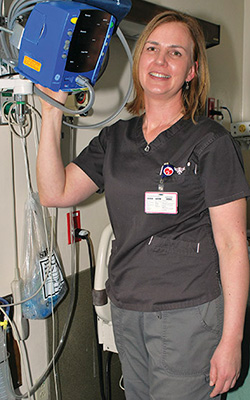
Eva Nunan, a medical / surgical nurse, checks a monitor in a patient’s room at UVM Medical Center. photo: Jan Doerler
|
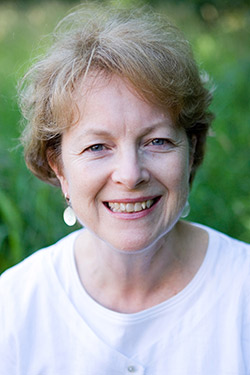
Pat Donehower
Photo: courtesy VNA |
Nurses are no strangers to moral dilemmas and moral distresses. In the first instance, the question becomes: What is the best or right thing to do? Moral distress involves not being able to do what is right due to various constraints. In one example, a navy nurse stood her ground when she was disciplined at Guantanamo for refusing to force-feed prisoners.
Other nurses advocate for patients who may not have all the information they need to give truly informed consent, or when they question the wisdom of a particular order. “Nurses need to be part of ethical decision making, and there are great opportunities for them to be advocates in a sophisticated and respectful way,” Pat Donehower says. “They must feel free to speak up, especially if their distress is related to a quality-of-care issue.”
Another challenge with ethical and quality-of-care implications is keeping up with necessary technology, while not losing sight of important interpersonal contact and communication. “The advent of the computer has helped in many ways,” says Felicia Robinson. “It’s easier now to quickly assess someone’s medical record, to see labs, to see what happened to them in the ER yesterday. But the computer can also be a barrier between the clinician and the patient. |

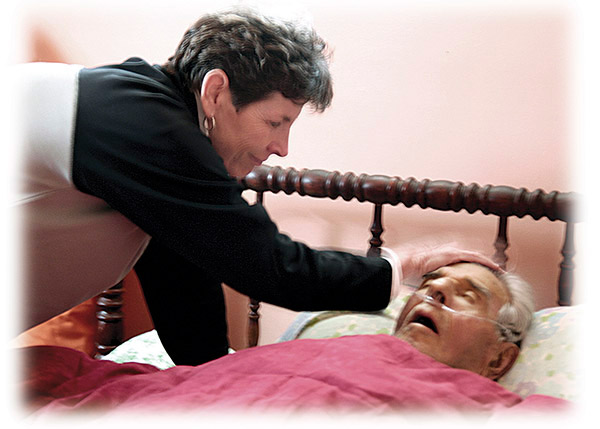
Mary Loney reveals her skills as a hospice and palliative care nurse as she comforts her father.
photo: Linda Hollingsdale
Mary Loney, RN, CHPN
Mary Loney, recipient of the 2014 Outstanding Home Health Nurse award from the Visiting Nurse Association (VNA) of Chittenden and Grand Isle Counties, began her career in 1974. After working in hospitals and rehabilitation facilities she shifted to home health and joined the VNA where she became a certified hospice and palliative care nurse. She had previously spent more than 20 years working with Vermont’s Department of Aging and Disability Division of Licensing and Protection.
When her best friend was diagnosed with terminal cancer at the age of 48, Mary decided to go back to hands-on nursing. “I wanted to get back to people and relationships, and what better way than to work with dying people. My friend became a hospice patient and died. I knew then that this was my life’s work.”
“Hospice nurses have established a credible identity, and physicians rely on them. Our expertise, passion, and commitment come across, so hospice nurses are held in high esteem,” she says. “The biggest thing is being on the journey with a person. I want the patient to be able to trust me, and I’m always honest with them. I want a good quality of life for them.”
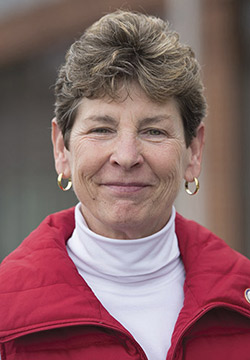
Mary Loney Photo: courtesy VNA |
As a nurse and midwife, I try to review the medical record before I enter the room so that I don’t have my face in the computer at first. Then I sit facing the patient and make eye contact to get her story. When I turn to the computer, I tell the patient that I want to be sure I am accurately reflecting what her concerns are. I read her exactly what I’ve written.
By doing this, my patient knows what I am doing at the computer, she’s involved in the process, and she can correct any misunderstandings. She feels confident I have ‘heard’ her.”
The Future of Nursing in an Ever-Changing Health System
Ever-evolving policies, practice norms, and financing mechanisms coupled with institutional systems changes mean new opportunities as well as challenges for nurses and other health-care providers. An article entitled “In Search of Joy in Practice,” which appeared in the Annals of Family Medicine in 2013, speaks to one of those opportunities.
The authors write about physician burnout, but their thesis could also apply to nurses. They point out that “the core work of primary care remains meaningful and rewarding, but this work has been crowded out by increasingly complex regulatory, technological, and administrative requirements. ... As a result, [many health providers] experience low levels of professional satisfaction …We believe a shift … to a shared-care model … and frequent forums for communication, can result in high-functioning teams, improved professional satisfaction, and greater joy in practice.”
Nurses know that teamwork and active communication are essential to good practice. As nurse Deb Clark puts it, “One of the great things about nursing is the variety of care that we bring as a team. I enjoy teaching patients what they need to know to take care of themselves. But someone else might be great at starting IVs. We come together in our work with a double set of eyes to make sure we are all doing the right thing. We work closely together to serve the patients and their families.”
As hospice nurse Mary Loney adds, “Teamwork is an integral, crucial element in our work. We are not independent practitioners, and we couldn’t do what we do without the whole team, including chaplains, pharmacists, social workers, doctors, and others. We also support each other because compassion fatigue is not uncommon in our work. We love what we do but we know that every time we say hello to a patient, we will also be saying good-bye. The team helps with that.”
Another relevant article published in 2013 in Academic Medicine reminds us of the vital role that nurses play in a changing health system. Examining how to “retool the existing workforce to practice in a transformed health system,” Erin P. Fraher, PhD, and her colleagues from the University of North Carolina/Chapel Hill write, “The US health care system employs 2.7 million registered nurses: it is nurses who are arguably in the most pivotal position to drive system change. Health systems are employing nurses in a host of innovative roles that span community, ambulatory, and acute-care settings.
Nurses are providing patient education and care coordination, improving care transitions between community and acute-care settings, conducting home visits for patients with complex chronic conditions, enhancing patient and family engagement, improving population health management, and increasing community outreach. These efforts have reduced unnecessary hospitalizations and readmissions, improved patients’ experiences, increased the quality of care provided, and lowered costs.” |
It is clearly an exciting time to be a nurse, as the nurses interviewed for this article know. “Nursing is an amazing career,” emergency room nurse Amanda Young says. “It takes a certain kind of person, and you have to choose it for the right reasons. But there’s no doubt about it: we are the backbone of health care.”  |
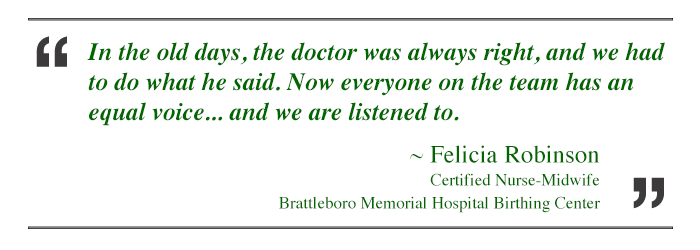
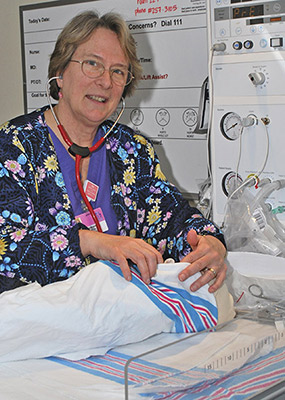
Felicia Robinson, a nurse-midwife,
tends to a newborn baby at the birthing center of
Brattleboro Memorial Hospital.
photo: Jan Doerler |
Felicia Robinson, CNM
A nurse-midwife for more than 20 years, Felicia Robinson is currently an instructor of obstetrics for nursing students at Keene State College and a staff nurse at Brattleboro Memorial Hospital’s Birthing Center. In May, she will complete her studies to become a family nurse practitioner. She has worked in obstetrics since 1983 and says it is “a passion.”
An activist at the old Boston City Hospital in 1988 when midwives were being challenged by physicians, Felicia notes that “things have changed” a lot since then. “In the old days, the doctor was always right, and we had to do what he said. Now everyone on the team has an equal voice. We’re all encouraged and empowered to speak up. And we are listened to.”
“There are many rewards to working as a nurse in obstetrics. It’s a privilege to participate in the birthing process and to help a couple become a family. It is an intense, exhausting, exciting time. We need to be able to ‘read’ the woman and to provide what she needs. And it’s rewarding when we feel we have met her needs. Other rewards are seeing the absolute love and joy on the face of a new mom or dad when they meet their newborn. A tangible energy fills the room, fills our hearts, and makes the long hours and hard work all worthwhile.” |
Amanda Young, RN
Amanda Young, a nurse for six years, works in the emergency room at the University of Vermont Medical Center. She moved to Vermont from Florida where she worked as a behavioral therapist, often with aggressive clients.
“The emergency room feels like what I did before, although it’s less hostile. I’m still dealing with crises and putting out fires. I like the speed, the drama, and the intensity of the moment.”
“My careers have always been very intense. I couldn’t do my job without a good team. When a really sick person comes in, we pull together and do what we have to do together. We see each other at our best and worst, and we comfort each other. You see what kind of people nurses are when you’re in this kind of situation.”
|
Amanda Young, emergency room nurse at the University of Vermont Medical Center, about to go home after an all-night shift. photo: Jan Doerler |
Vermont Nursing Programs
Castleton College
86 Seminary Street
Castleton, VT 05735
800-639-2800 • www.castleton.edu
BS in Nursing
Community College of Vermont
Twelve locations statewide & online
802-828-2800 •
www.ccv.edu
Allied Health Preparation,
Certificate
STEM Studies, AD in Science
Both programs prepare students for transfer into four-year nursing programs.
Norwich University
158 Harmon Drive
Northfield, VT 05663
802-485-2600 • www.norwich.edu
BS in Nursing
MS in Nursing |
Southern Vermont College
982 Mansion Drive
Bennington, VT 05201
802-447-6300 • www.svc.edu
Pre-Licensure BS in Nursing
RN to BS in Nursing
University of Vermont
College of Nursing and Health Services
105 Rowell Building
106 Carrigan Drive
Burlington, VT 05405
802-656-3858
www.uvm.edu/~cnhs
BS in Nursing
RN to BS in Nursing
MS in Nursing:
Clinical Nurse Leader
MS in Nursing: Nurse Practitioner
Post Master’s Certificate
Direct Entry Program in Nursing
Doctor of Nursing Practice
Post Master’s Doctor of Nursing Practice
|
Vermont Tech
PO Box 500
Randolph Center, VT 05061
800-442-8821 • www.vtc.edu
Practical Nursing Program,
Certificate
AD in Nursing
BS in Nursing (online) |
Sources
American Association of Colleges of Nursing. “AACN Applauds New Study that Confirms Link Between Nursing Education and Patient Mortality Rates.” September 23, 2003, press release.
American Association of Colleges of Nursing. “Creating a More Highly Qualified Nursing Workforce.” www.aacn.nche.edu/media-relations/fact-sheets/impact-of-education.
Blue Ribbon Commission on Nursing, State of Vermont.
http://governor.vermont.gov/executive_orders/10-11-blue-ribbon-commission-on-nursing.
Fraher E. P., T. C. Ricketts, A. Lefebvre, and W. P. Newton. “The Role of Academic Health Centers and Their Partners in Reconfiguring and Retooling the Existing Workforce to Practice in a Transformed Health System.” Academic Medicine 88, no. 12 (December 2013).
McGee, Emily. “Failure to Rescue.” Advanced Health Care Network for Nurses blog, March 13, 2009. http://nursing.advanceweb.com/Editorial/Search/SearchResult.aspx?KW=Emily%20McGee.
Morton, Christine H., and Elayne G. Clift. Birth Ambassadors: Doulas and the Re-emergence of Woman-Supported Birth in America. Amarillo, TX: Praeclarus Press, 2014.
Sinsky, Christine A., MD, Rachel Willard-Grace, MPH, Andrew M. Schutzbank, MD, Thomas A. Sinsky, MD, David Margolius, MD, and Thomas Bodenheimer, MD. “In Search of Joy in Practice: A Report of 23 High-Functioning Primary Care Practices.” Annals of Family Medicine 11, no. 3 (May/June 2013). www.annfammed.org.
|











